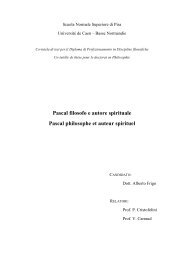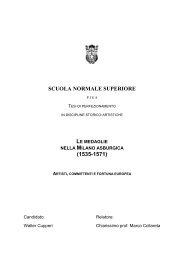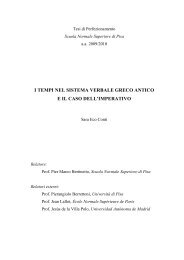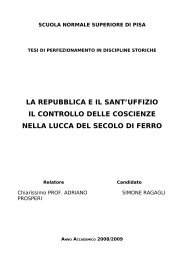CATULLUS 68 - Scuola Normale Superiore
CATULLUS 68 - Scuola Normale Superiore
CATULLUS 68 - Scuola Normale Superiore
Create successful ePaper yourself
Turn your PDF publications into a flip-book with our unique Google optimized e-Paper software.
One is the theme of human and divine relationships, of what could be termed ‘social interaction’. Catullus’<br />
liaison with Lesbia is compared explicitly to the marriage of Protesilaus and Laodamia, and to that of Jupiter<br />
and Juno. All three are presented in a positive light, even the last one of the three: the supreme god may be a<br />
notorious philanderer, but his marriage is treated as the prototype of all marriages and love-affairs, human or<br />
divine. Hercules’ marriage to Hebe also receives a brief mention (line 116). Lesbia’s cuckolded husband<br />
receives no consideration – we only know that he exists because Catullus gloats that he has snatched her<br />
from his very lap (146); nor do Lesbia’s other lovers, who are not mentioned anywhere at all – we only get to<br />
know Catullus is not enough for Lesbia on his own (135). In case there remains space for any<br />
misunderstanding, I would like to add that they have not been airbrushed out by Catullus: he has simply<br />
ignored them, as one can ignore almost any obstacle when one is in love. It is a more impressive feat of<br />
selective thinking that Catullus extols his own adulterous relationship with Lesbia (lines 135-148, esp.<br />
143ff.), while using strong terms to denounce that of Paris and Helen (103f.). Evidently he has not stopped to<br />
think about the potential implications of his opinion about them.<br />
Another type of relationship prominent in the poem is that between peers: the friendship between Allius and<br />
Catullus; the bond between Catullus and his brother; and the solidarity of the Greek heroes who went to fight<br />
under Troy (cfr. lines 101-104). Once more the figures who do not fit into the pattern are passed over<br />
quickly, not only Paris, but also Eurystheus (114). The hyper-optimistic quality of this poem also explains a<br />
glaring omission, that while we get to know that before Allius entered the scene Catullus could not start a<br />
relationship with Lesbia, and that he was desperate about this (cfr. lines 51-56 and 67), but we are not told<br />
who was not letting them get together, how, why. After Allius’ intervention and the happy first rendez-vous<br />
such questions evidently ceased to matter. In short, the poem describes mankind attaining happiness through<br />
love and through friendship.<br />
Another red thread running through the text, though a much more elusive one, is an attention to beauty,<br />
movement, thought, knowledge, development. Lesbia’s beauty is described in two memorable passages<br />
(lines 70-72 and 133f.). Laodamia is pulcerrima, ‘most beautiful’ (105). No more is said explicitly about<br />
these matters, but I believe that with its images depicting the beauty of nature (57-62), the pleasures of love<br />
(125-130) and happiness in general (63-65, 119-124) and with its choice assortment of delightful thought,<br />
rhythm, sound and language the poem depicts, celebrates and enacts human happiness. There are dark<br />
patches, to be sure – the loss of life under Troy, and Laodamia’s bereavement and unhappy widowhood – but<br />
these do not weigh up against Catullus’ happiness with Lesbia, they do not threaten their present and future<br />
joys.<br />
Catullus <strong>68</strong>b is, in short, a celebration of happiness attained through love and through friendship. I see it as a<br />
true literary masterpiece.<br />
73






